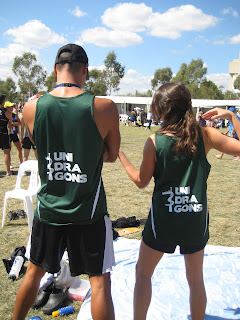I returned to Arnhem Land, Northern Territories for a two week research trip in July. Joining a research team of about 14 students and 12 professors, groups of us set out on daily 8-hour expeditions to search for undiscovered rock art sites. We found 30+ sites, and I took part in documenting, photographing, and drawing the art for conservation and research purposes.
This area is closed to non-Aboriginal people without a permit, yet we were given special permission by the community elders (specifically Jacob whom you will see in the video below) to camp there, record rock art, and excavate near a cave shelter site.
The local news did a story on our research team (I am shown at the excavation pit at minute 4:42!):
 |
| A shelter site we worked at that had many rock art paintings and burials |
 |
| We used a PRXF machine to non-invasively analyse the rock art pigment |
 |
| Team member Jakob at the total station device used to survey and map the excavation sites |
 |
| Jakob holding the reflector that is used in conjunction with the total station |
 |
| Jack is a researcher from the United States who is now working at ANU on a GPS mapping survey project |
 |
| Our team in front of a rock art site we found and documented |
 |
| Photographing a large rock art complex we found high in the escarpment |
On the last day of the trip, our lead researcher asked me to lead an expedition team to search for rock art images that he needed for his book -- specifically, art that depicted post-contact objects (guns, buffaloes, ships, etc.) Together with Hilton and Adelais (shown in photo), we found and documented about ten unrecorded sites.
 |
| On the search for rock art sites |
 |
| Brad in the excavation pit under a rock shelter site |
 |
| Where we camped for two weeks |
 |
| On the way back to Darwin from Arnhem Land we stopped at a croc park. Timmy (holding the fish) is one of the professor's sons. |
 |
| Celebrating the end of a successful research trip with a sunset dinner in Darwin |







































